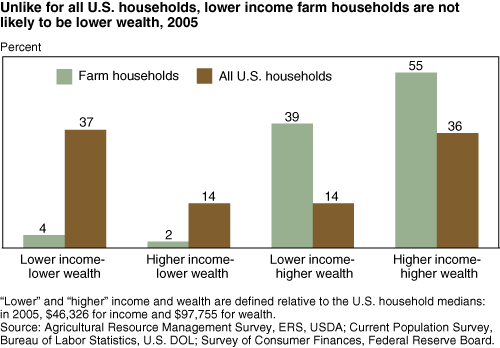Income an Incomplete Measure of Farm Household Well-Being
- by Carol Jones and Ashok K. Mishra
- 6/1/2007
For more than a decade, average farm household income has exceeded the U.S. household average by around 15 percent. However, farm household income is more variable. At the same time, the wealth of farm households, like other households with self-employed heads, tends to be substantially higher than the wealth of the average U.S. household. Most of the wealth of farm households is in farm land and equipment and facilities for production.
In a variable-income/high-wealth sector such as farming, well-being measures based on both income and wealth can provide a better indication of a household’s capacity to maintain its standard of living than a measure of income taken in a single year. During downturns in income, farm households may be able to borrow against, or liquidate, assets.
To create a joint income-wealth well-being measure, we divided households into four groups, separating them into low and high levels of income, and low and high levels of wealth—with the median levels of U.S. household income or wealth as the dividing lines between low and high. Median income (or wealth) is the level at which 50 percent of households have greater income (wealth) and 50 percent have less.
In 2005, farm household median income was about 20 percent higher than the median for all U.S. households ($53,779 versus $46,326), while farm household median wealth was five times greater ($510,018 versus $97,755). And wealth is more evenly distributed across all farm households than it is among all U.S. households. For all U.S. households with self-employed heads, median household income ($68,701) is 27 percent higher than for farm households, whereas median wealth ($352,380) is about a third lower than for farm households.
As a rule, higher income U.S. households also have higher wealth, and lower income households have lower wealth. The combination of low income and wealth can indicate low economic well-being. But because nearly all farm households are high wealth, the pattern is substantially different for farm households relative to all U.S. households. Lower income farm households are not more likely to be lower wealth. In 2005, 37 percent of all U.S. households were in this category, compared with 4 percent of farm households.
This article is drawn from:
- Farm Household Well-being. (n.d.). U.S. Department of Agriculture, Economic Research Service.
- Agricultural Income and Finance Outlook, 2006. (2008). ERS.



